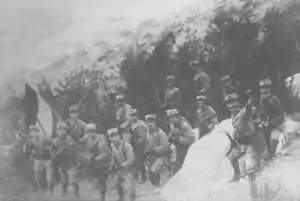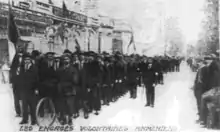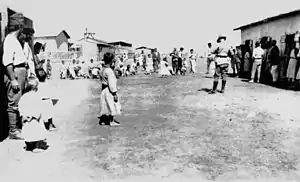French Armenian Legion
The Armenian Legion (French: Légion arménienne) was a foreign unit within the French Army active during and just after World War I which fought against the Ottoman Empire. The original name of the legion was "La Légion d'Orient" (The Eastern Legion).[3] It was renamed "La Légion Arménienne" (The Armenian Legion) on February 1, 1919. The soldiers in this legion were referred to informally among Armenians as Gamavor (Volunteer).
| Armenian Legion | |
|---|---|
 | |
| Active | 1916–1920 |
| Country | |
| Size | 4,124 (1916–1918)[1] 10,150 (1920–1921)[2] |
| Nickname(s) | "La Légion d'Orient" |
| Engagements | Battle of Arara (Sinai and Palestine Campaign), Battle of Marash, Franco-Turkish War |
| Commanders | |
| Ceremonial chief | Boghos Nubar |
Background

Many Armenians living in France volunteered to join the French Foreign Legion at the beginning of the war. This was prior to the establishment of the French Armenian Legion.
Nearly all the able-bodied Armenians in France, between 1000 and 1500 strong, joined the French Foreign Legion quite early in the war. Some Armenians came from the United States to fight for France. Only some 250 have survived, I understand, most of whom are proud possessors of the Military Cross.[4]
Establishment
Negotiations of Boghos Nubar with French political and military authorities culminated in the formation of the French Armenian Legion.
The Legion was established officially in Cairo, Egypt in November 1916, with the accord of the French Ministry of Foreign Affairs and an Armenian delegation. Several Armenian organizations pledged contributions to form several battalions under the planned Armenian Legion.
The parties agreed to the following:
- The aim of creating the Legion was to allow Armenians' contribution to the liberation of the Cilicia region in the Ottoman Empire and to help them to realize their national aspirations of creating a state in that region.
- The Legion was to fight only Turks and only in Cilicia.
- The Legion was to become the core of a planned future Armenian Army.
Initial plans
Signed in Paris by General Pierre Roques, Minister of War, and General Marie-Jean-Lucien Lacaze, Minister of Navy, the official decision regarding the establishment of the Armenian Legion was signed on 15 November 1916 in Paris.
According to this initial decision,
- The Eastern Legion was to be stationed in Cyprus
- Armenians and Syrians of Ottoman nationality would be permitted to volunteer
- The Legion would be commanded by French officers
- Volunteers for the Legion would have an equivalent status compared to French soldiers and would be under the responsibility of the French War Ministry
- Major Louis Romieu would supervise the establishment of the Legion
- The Legion was to be deployed in Cilicia, on the southeastern coast of Asia Minor (modern Turkey)[5]
- 10,000 Francs were to be allocated from the war budget of the French Navy to use in the establishment of camps
- The volunteers were to be organized by local Armenian committees and sent to Bordeaux and Marseille. The committees were to be reimbursed by French government for travel expenses.
Order of Battle, 1916–1918

The number of volunteers was an equivalent of 6 battalions, each containing 800 volunteers, and another 6 battalions were planned to be formed. Armenian committees were organizing to recruit these soldiers in France and the United States.
The Legion included Ottoman Armenian refugees, former prisoners of war, and permanent residents of Egypt, America, and Europe, and was 95% Armenian in composition. The majority of the soldiers were said to be recruited from the Armenian-American community or survivors of the battle of Musa Dagh who were living in refugee camps in Port Said, Egypt, at the time.
After the initial training in Cyprus, the Armenian Legion joined the Détachement Français de Palestine et de Syrie, taking part in the Sinai and Palestine campaign against the Ottoman army and its German ally. The two battalions of the legion were supplemented by an Infantry company of recruits from Syria and a platoon of two 37mm infantry guns.[6]
Under the command of General Edmund Allenby, the Legion, fighting in Palestine, Syria, and, finally, Cilicia, won the plaudits of Clemenceau’s government and its Entente allies."[7] The Armenian Legion assisted the British and French in winning the decisive Battle of Arara and has been credited with making General Allenby's victory possible.[8]
Order of Battle, 1920–1921
Following this campaign, the Armenian Legion was deployed in Anatolia (Asia Minor) according to the initial decisions. They were active around the cities of Adana and Mersin involved in skirmishes with local civilians and unorganized Turkish militia.[9]
References
- Hamelin to Defense, document 53/G-11 of 12 January 1919, A.VA
- Ahmet Hulki Saral: Türk İstiklal Harbi Güney Cephesi IV, Ankara 1996, page 47
- Archived May 27, 2006, at the Wayback Machine
- Armenia and the War: An Armenian's Point of View with an Appeal to Britain ... - Page 80 by Avetoon Pesak Hacobian
- Archived September 29, 2007, at the Wayback Machine
- "Chapitre VI: Renforcement du détachement français de Palestine". Les armées françaises dans la Grande guerre. Tome IX. 1er Volume. Théatre d'opérations du Levant. Ministère De la Guerre, Etat-Major de l'Armée - Service Historique (in French) (1st ed.). Paris: Imprimerie Nationale. 1936. p. 97. Retrieved 20 August 2020.
- Richard G. Hovannisian, Armenia on the Road to Independence,' 1967
- King, William C. (1922), King's complete history of the World War : visualizing the great conflict in all theaters of action, 1914-1918, Springfield, Massachusetts: The History Associates, p. 666
- "Jim Chankalian". Armeniapedia.org. Retrieved 2015-05-31.
Further reading
- Pattie, Susan Paul (2018). The Armenian Legionnaires: Sacrifice and Betrayal in World War I. I.B. Tauris (Bloomsbury). ISBN 978-1-78831-125-0.
See also
- Armenian Legion (disambiguation)
- Franco-Armenian relations
- French Foreign Legion